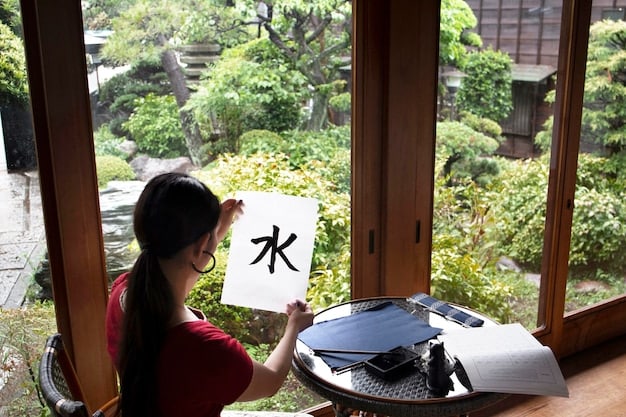Lost in Translation: Decoding Japanese Humor in J-Dramas for US Viewers

Lost in Translation? Common Misinterpretations of Japanese Humor in J-Drama Comedies explores how cultural nuances often lead to misunderstandings of comedic elements in Japanese dramas for American audiences, examining specific types of humor and offering insights for better appreciation.
Japanese dramas, or J-dramas, have captivated audiences worldwide with their unique storytelling and compelling characters. However, the humor embedded within these shows can sometimes be lost on viewers unfamiliar with Japanese culture. This article delves into common misinterpretations of Japanese humor in J-Drama comedies, helping US audiences better understand and appreciate the comedic nuances.
Understanding the Landscape of Japanese Comedy
Japanese comedy, known as “owarai,” encompasses a variety of styles and traditions deeply rooted in Japanese culture. To fully appreciate the humor in J-dramas, it’s crucial to understand these foundational elements.
The Importance of “Manzai” and “Conte”
“Manzai” and “Conte” are two prominent forms of Japanese stand-up comedy that often influence the comedic elements in J-dramas. Understanding their structures can shed light on the jokes and skits performed in the shows.
- Manzai: Typically involves two comedians, a straight man (tsukkomi) and a funny man (boke), engaging in rapid-fire banter, often with physical comedy.
- Conte: Short, scripted skits that focus on absurd or everyday situations, relying heavily on character-driven humor and witty dialogue.
- Influence on J-Dramas: Many J-dramas incorporate elements of Manzai or Conte, using similar comedic timing and character archetypes.
- Example: A scene where characters mimic Manzai routines, highlighting the absurdity of a situation.
These traditional comedic formats lay the groundwork for many of the comedic situations and character interactions seen in J-dramas, making familiarity with them essential for understanding the humor.

Common Types of Japanese Humor and Their Pitfalls
Several distinct types of humor are prevalent in Japanese comedy. However, these forms can present challenges for viewers unfamiliar with Japanese cultural norms and language.
“Gag” Humor and Slapstick
“Gag” humor, similar to slapstick, relies on exaggerated physical actions and silly situations to elicit laughter. While seemingly universal, even this style can be misunderstood.
- Exaggerated Reactions: Japanese comedians often use exaggerated facial expressions and physical reactions to amplify comedic effect.
- Visual Gags: Physical pranks and absurd situations are common, sometimes involving objects or surroundings.
- Cultural Context: Some gags may reference specific aspects of Japanese culture, holidays, or folklore, requiring background knowledge to fully understand.
- Potential Misinterpretations: Western audiences may find some gags too over-the-top or nonsensical without understanding the cultural context.
Understanding the specific cultural references and comedic timing is essential to appreciating “gag” humor in J-dramas.
Language-Based Humor: Puns and Wordplay
A significant portion of Japanese humor relies on puns and wordplay, which are difficult to translate and often lose their comedic value in subtitles.
The Challenge of Translating Puns
Japanese language is rich with homophones (words that sound alike but have different meanings), which are a fertile ground for puns. However, these puns rarely translate directly into English.
- Homophone-Based Humor: Many jokes hinge on the double meaning of words that sound alike, creating unexpected and humorous twists.
- Cultural Idioms: Japanese also incorporates idioms and set phrases that have inherent comedic value for native speakers.
- Lost in Translation: Subtitles can only convey the literal meaning, missing the humorous intent of the wordplay.
- Strategies for Understanding: Looking up the original Japanese word or consulting online forums can sometimes reveal the intended pun.
Language-based humor in J-dramas presents a significant barrier to understanding for non-Japanese speakers, requiring extra effort to decipher the intended comedic effect.

Cultural Context is King: Understanding Social Norms
Many comedic situations in J-dramas are based on cultural norms and social expectations unique to Japan. Without this understanding, jokes can fall flat or even be offensive.
Hierarchy, Formality, and “Face”
Japanese society places a strong emphasis on hierarchy, formality, and maintaining “face” (saving face). These values often fuel comedic interactions.
- Respect for Seniors: Jokes may revolve around characters humorously flouting or upholding traditional respect for elders.
- Office Culture: J-dramas frequently depict the peculiarities of Japanese office culture, including rigid hierarchies and long work hours.
- Embarrassment and “Face”: Situations involving public embarrassment or loss of “face” can be a source of humor, though the undertones might be subtle.
- Navigating Nuances: Understanding these social dynamics allows viewers to appreciate the layers of humor in seemingly simple interactions.
Cultural context provides the foundation for many comedic situations in J-dramas, making awareness of Japanese social norms essential for full appreciation.
Self-Deprecating Humor and Humility
Self-deprecating humor is another staple of Japanese comedy, often used to create relatable and endearing characters. However, the subtlety can be easily missed.
The Art of Downplaying Oneself
In Japanese culture, humility is highly valued. Self-deprecating humor allows characters to poke fun at themselves, showcasing their down-to-earth nature.
- Subtle Jabs: Characters may make light of their own shortcomings, failures, or insecurities, creating moments of gentle humor.
- Contrast with External Perception: The humor often arises from the contrast between a character’s self-perception and how others view them.
- Relatability: Self-deprecation makes characters more relatable and likable, as viewers can identify with their flaws and vulnerabilities.
- Potential Misinterpretations: In some cases, US viewers may not recognize the humor and take the self-deprecating comments at face value.
Recognizing self-deprecating humor in J-dramas adds depth to the viewing experience, highlighting the characters’ vulnerability and humanity.
How Subtitles Can Help (and Hinder) Understanding
Subtitles are crucial for understanding J-dramas, but they also have limitations, potentially leading to misinterpretations of humor.
The Trade-offs of Subtitling
Subtitles aim to bridge the language gap, but they often struggle to convey the nuances of Japanese humor, especially puns and cultural references.
- Literal Translations: Subtitles often provide literal translations, missing the implied meaning or comedic intent of the original dialogue.
- Explanatory Notes: Some subtitles include annotations to explain cultural references or puns, but these can be distracting.
- Different Interpretations: Different subtitling groups may interpret jokes differently, resulting in varying degrees of comedic effectiveness.
- Active Viewing: Viewers should actively engage with subtitles, considering the context and cultural background to understand the humor.
While subtitles are essential, active viewing and an awareness of their limitations can enhance the understanding and appreciation of humor in J-dramas.
Tips for US Viewers to Better Appreciate J-Drama Humor
To overcome the challenges of cultural and linguistic differences, here are some practical tips for US viewers looking to better appreciate J-drama humor.
Immerse Yourself in Japanese Culture
The more familiar you are with Japanese culture, the better equipped you’ll be to understand the humor in J-dramas.
- Watch Other Japanese Media: Explore other forms of Japanese entertainment, such as variety shows, anime, and movies, to gain cultural insights.
- Read About Japanese Culture: Research Japanese customs, social norms, and historical events to broaden your understanding.
- Engage with Japanese Communities: Participate in online forums or social media groups dedicated to Japanese culture and J-dramas to exchange insights and ask questions.
- Embrace Curiosity: Be open to learning and exploring new things, viewing each J-drama as an opportunity to delve deeper into Japanese culture.
Cultural immersion is key to unlocking the layers of humor hidden within J-dramas, transforming the viewing experience from passive to deeply engaging.
| Key Element | Brief Description |
|---|---|
| 😂 Gag Humor | Exaggerated actions & silly situations, needs cultural context. |
| 🗣️ Language Puns | Wordplay often lost in translation; explore original terms. |
| 🎎 Social Norms | Hierarchy and saving “face” influence comedic interactions. |
| 😔 Self-deprecation | Humility valued; characters often poke fun at themselves. |
Frequently Asked Questions
▼
Japanese humor is deeply intertwined with its culture, language, and social norms, which can be unfamiliar to international viewers. This creates a barrier in understanding jokes and comedic situations.
▼
Puns in Japanese comedy often utilize homophones, words that sound the same but have different meanings. This wordplay is challenging to translate and appreciate without knowledge of the language.
▼
“Manzai” is a traditional form of Japanese stand-up comedy with two performers: the “boke” (funny man) and the “tsukkomi” (straight man). It’s a significant influence on many J-drama comedy scenes.
▼
Subtitles are essential for understanding the dialogue but can sometimes miss nuances of the humor, especially with puns and cultural references. Active viewing is key.
▼
Immerse yourself in Japanese culture by watching various forms of media, reading about customs, and engaging with Japanese communities online.
Conclusion
While the unique nuances of Japanese humor in J-Drama comedies may initially seem lost in translation, with a deeper understanding of Japanese culture, language, and comedic traditions, US viewers can unlock a richer and more rewarding viewing experience, appreciating the subtleties and comedic brilliance of these beloved shows.





